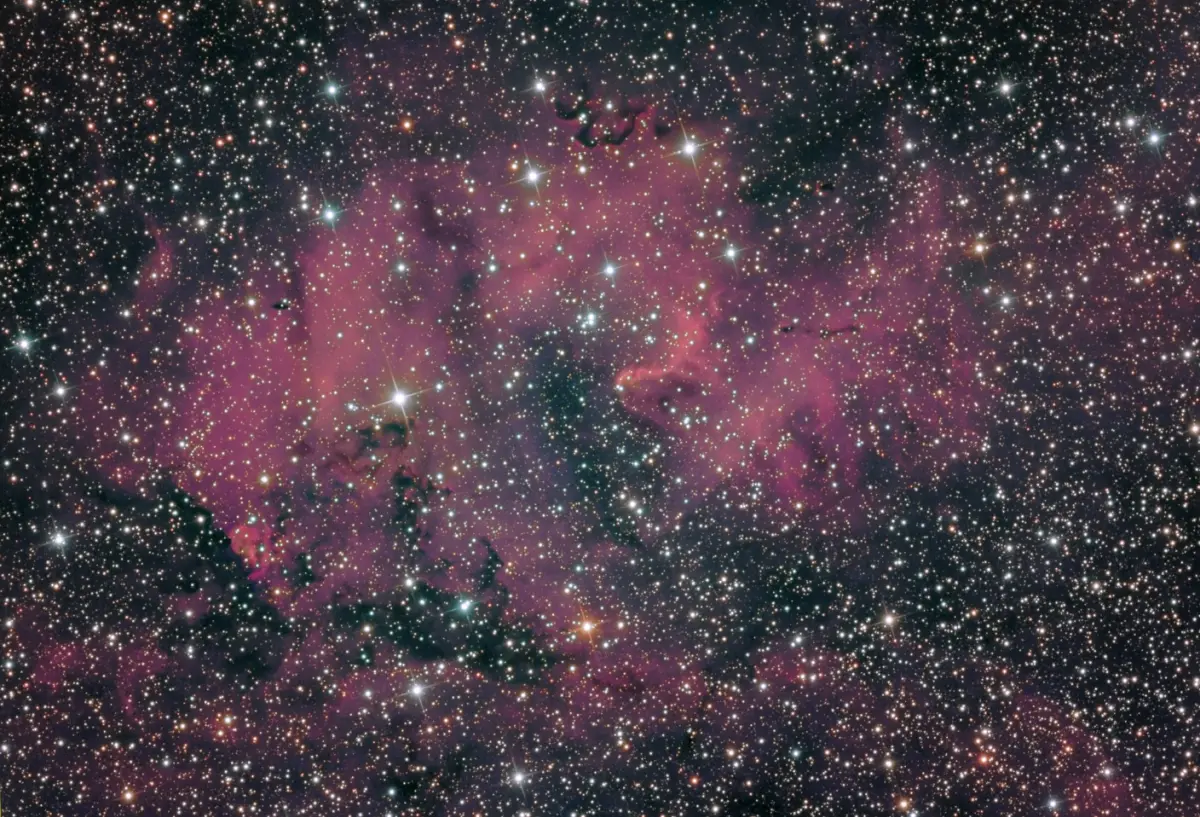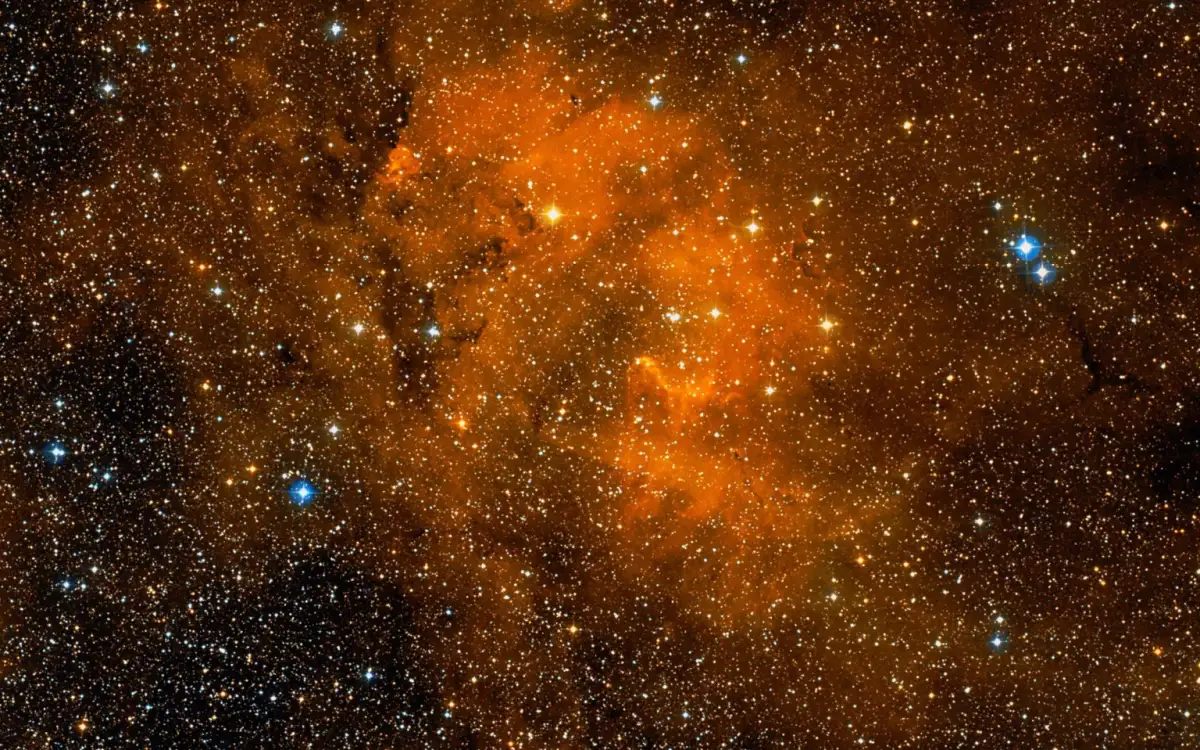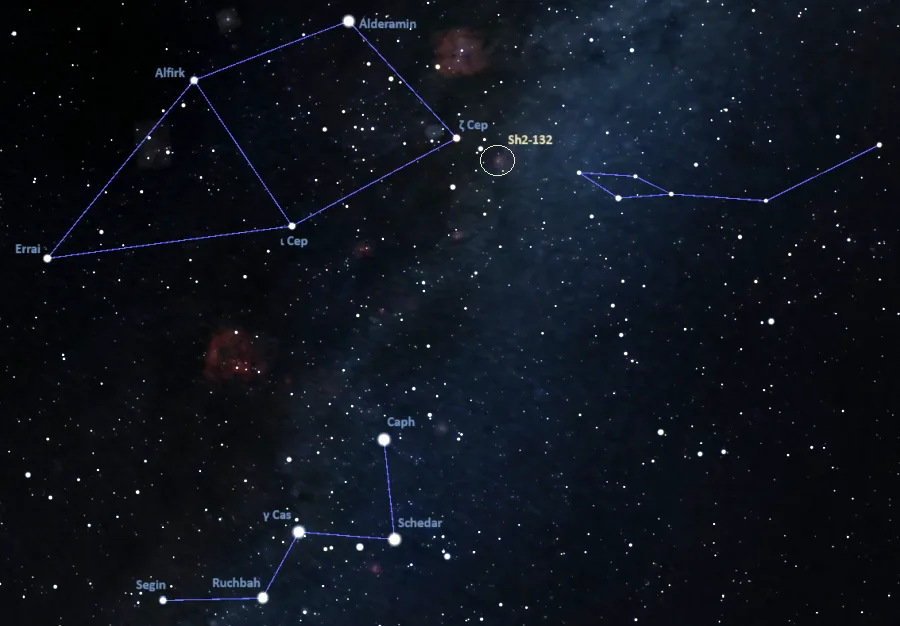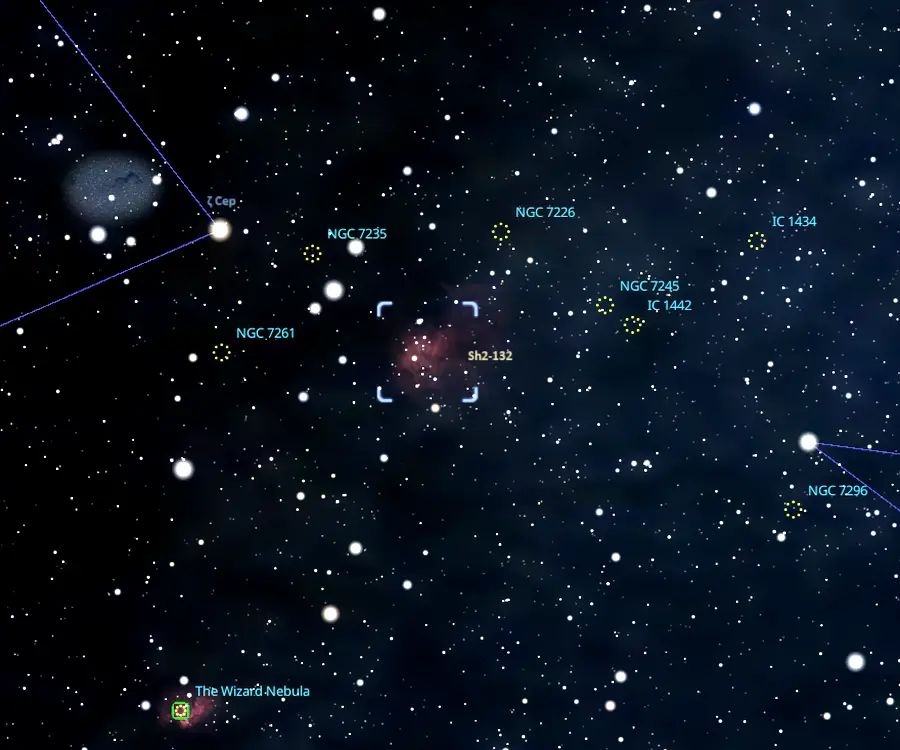The Lion Nebula is an emission nebula located approximately 10,400 light-years away in the northern constellation Cepheus. It is sometimes also called the Fish Nebula. The nebula has low surface brightness and is a difficult object to observe in amateur telescopes. It is listed as Sharpless 132 (Sh2-132) in the Sharpless catalogue of H II regions.
The Lion Nebula has an apparent size of 40 arcminutes, corresponding to a physical diameter of around 250 light years. It lies in the Perseus Arm of the Milky Way galaxy. The Perseus Arm is one of our galaxy’s major spiral arms. It hosts many bright and well-known deep sky objects, including the Double Cluster in Perseus, the Crab Nebula in Taurus, and the open clusters Messier 52 and Messier 103 in Cassiopeia.
Sharpless 132 is part of the Cepheus OB1 association. The hot, luminous blue stars of the massive stellar association are responsible for ionizing the nebula’s gases and making them emit their own light. These massive stars include the Wolf-Rayet stars HD 211564 and WR 153 (HD 211853), a massive star with the spectral class O8.5V, and up to a dozen blue B-type stars.

Lion Nebula (Sharpless 132), image credit: Wikisky/Astrophoto survey (CC BY 4.0)
The stellar winds of the O-type star and one of the Wolf-Rayet stars are believed to be responsible for producing a bubble-like shell, called Shell B, around the stars. The bubble is visible in the radio band. A smaller shell, Shell A, envelops an orange K-type star. The nebula is also known to contain a water maser and nine sources of infrared radiation.
The whole region contains both emission nebulosity and dark clouds of dust that absorb the light of the stars and nebulosity in the background. The most prominent of the dark dust regions is catalogued as Barnard 369. It appears next to the lion’s ear. The dark and bright nebulae in the region form the shape of a lion’s head and mane.
The rich H II region was once a site of chain star formation, but astronomers have not found evidence of recent activity.
Facts
The Lion Nebula was discovered by the American astronomer Stewart Sharpless on photographic plates taken with the 48-inch Schmidt telescope as part of the Palomar Observatory Sky Survey in the 1950s. Sharpless originally included the nebula as Sh 1-91 in his catalogue of 1953. In his updated catalogue published in 1959, he noted, “Part of II Cep association.”
The nebula was previously spotted by the American astronomer Edward Emerson Barnard, but Barnard did not catalogue it. He noted, “some irregular, feeble nebulosity here, about a degree in extent.” E. E. Barnard listed a “round, dusky” dark nebula about 13 arcminutes northeast of the star BD +55°2709 in his catalogue. The dark nebula later appeared as Barnard 369 in A Photographic Atlas of Selected Regions of the Milky Way (1927), which combined both volumes of Barnard’s Atlas.
American astronomer Beverly Turner Lynds included the nebula as LBN 102.79-00.92 (LBN 473) in her 1965 Catalogue of Bright Nebulae, based on a study of the prints of the National Geographic-Palomar Observatory Sky Atlas.
Lynds had previously listed several dark nebulae that appear in the direction of the nebula Sh2-132 as LDN 1150 (B369), LDN 1154, LDN 1156, LDN 1161, and LDN 1162 in her Catalogue of Dark Nebulae of 1962.
Sharpless 132 is not to be mistaken for the planetary nebula NGC 2392 (Caldwell 39), which is sometimes also called the Lion Nebula, but is more commonly referred to as the Eskimo Nebula or the Clown Face Nebula.

Lion Nebula, image credit: ESO/Digitized Sky Survey 2 (CC BY 4.0)
Location
The Lion Nebula appears in the far northern sky, in the relatively inconspicuous constellation of the King (Cepheus). It lies in the southern portion of Cepheus, near the border with Lacerta (the Lizard). The nebula appears close to the red supergiant Zeta Cephei (mag. 3.35), one of the five relatively bright stars that form the House of Cepheus, an asterism that looks like a stick house.
The stars of Cepheus can be found using the brighter and more prominent Cassiopeia. A line from Schedar through Caph in Cassiopeia’s W leads to Alderamin, the brightest star in Cepheus. Alderamin forms the base of the stick house asterism with Zeta Cephei.

Location of the Lion Nebula (Sh2-132), image: Stellarium
The Lion Nebula appears in the same region as several relatively bright open star clusters. These include NGC 7235, NGC 7261 and NGC 7226 in Cepheus, and NGC 7245, IC 1442 and IC 1434 in Lacerta. The larger Elephant’s Trunk Nebula (IC 1396) appears in the same area, in the same line of sight as the luminous supergiant or hypergiant Mu Cephei (Garnet Star). The Wizard Nebula (NGC 7280) appears a little further away, in the direction of Cassiopeia.

Star clusters and nebulae near the Lion Nebula, image: Stellarium
At declination +56°, the Lion Nebula is best seen from the northern hemisphere. It never rises for observers south of the latitude 34° S. Due to its faintness, it is best seen in long-exposure photographs.
The best time of the year to observe deep sky objects in Cepheus is during the month of November, when the constellation appears higher in the sky around 9 pm. For northern observers, the constellation is visible throughout the year.
Lion Nebula – Sh2-132
| Constellation | Cepheus |
| Object type | Emission nebula |
| Right ascension | 22h 19m 09.0s |
| Declination | +56° 04′ 45″ |
| Apparent size | 40’ |
| Size | 250 light years |
| Distance | 10,400 light-years (3,200 parsecs) |
| Names and designations | Lion Nebula, Sharpless 132, Sh2-132, LBN 473, LBN 102.79-00.92, IRCO 34, Mol 143, WB89 170 |